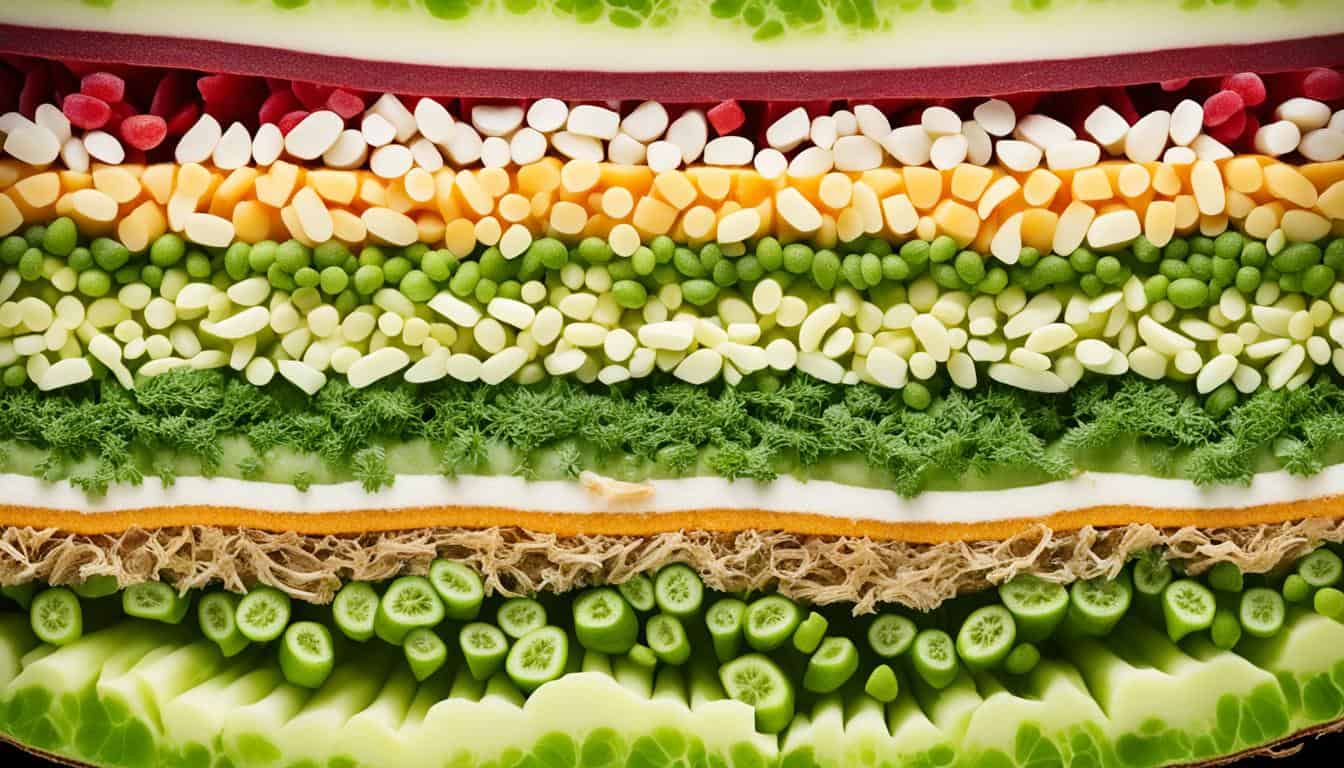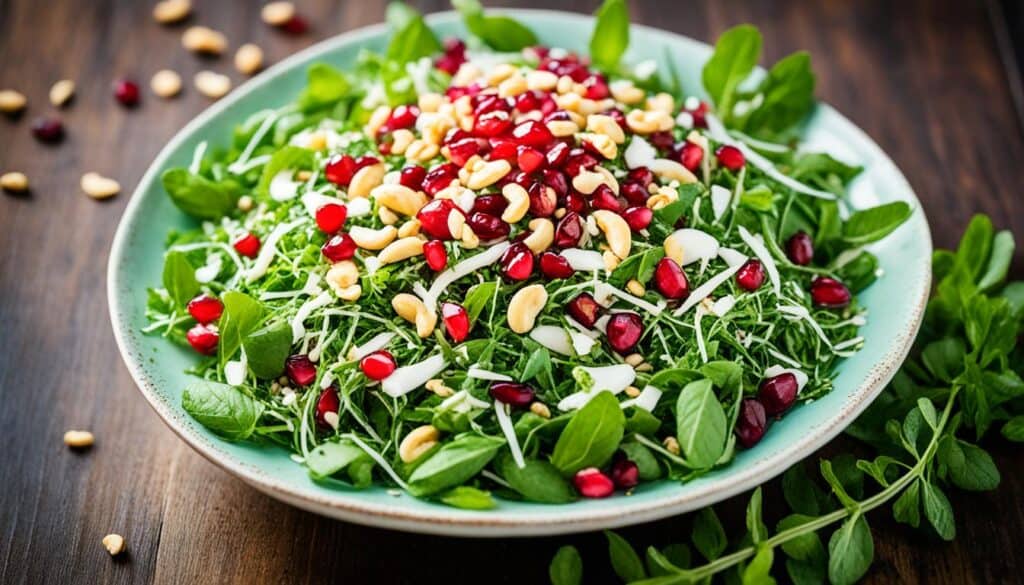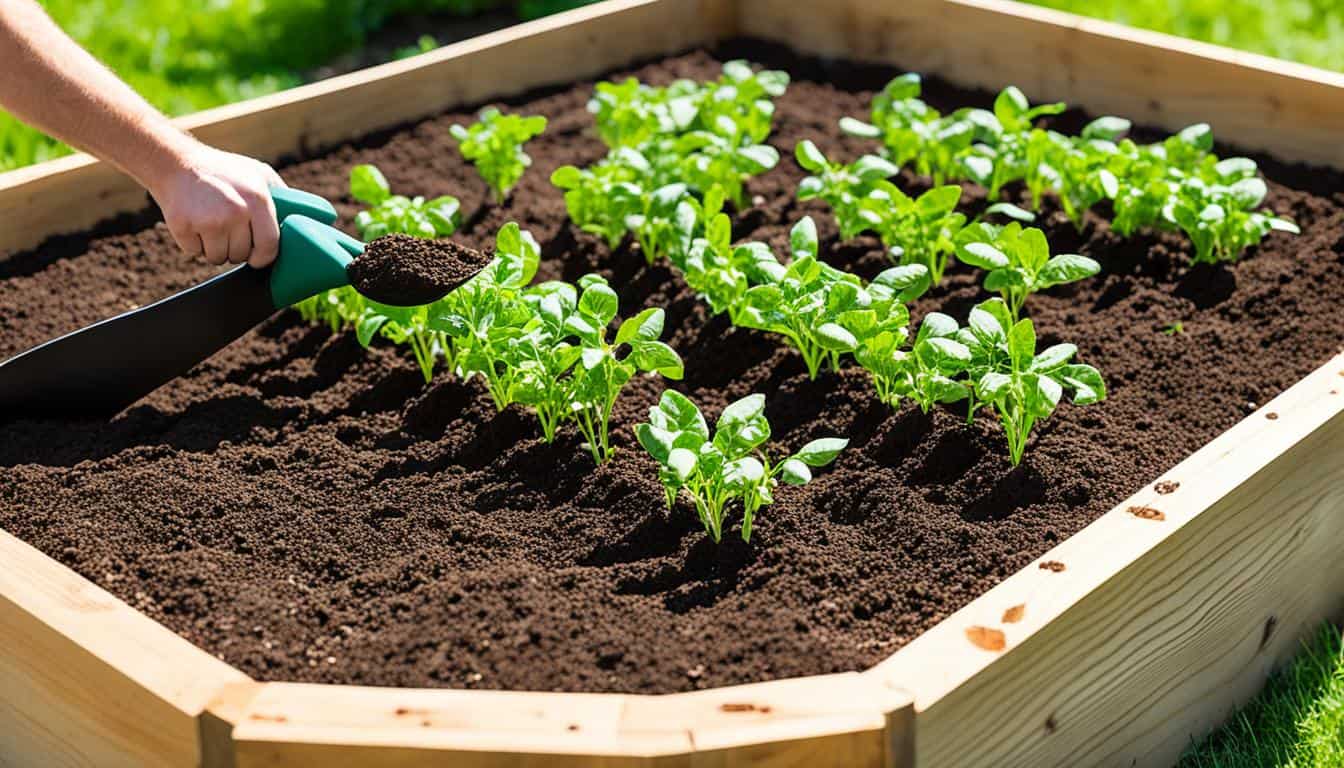Did you know that mooli, also known as white radish or daikon, is a vegetable with numerous health benefits?
Widely used in Indian cuisine, mooli can be cooked in various ways, adding a unique flavor to dishes. Whether you’re looking for a delicious recipe, want to discover the health benefits, or simply curious about how to cook mooli, this article is your guide to unlocking the secrets of this versatile veggie.
Key Takeaways:
- Explore the health benefits of mooli, including its high vitamin C content and fiber-rich properties.
- Discover delicious mooli recipes to try, from stir-fries and pickles to parathas and salads.
- Understand mooli’s role in Indian cuisine and how it can enhance the flavors of curries, lentil soups, and more.
- Learn about the nutritional value of mooli and how it can support a healthy diet.
- Get tips for cooking mooli and incorporating it into your favorite dishes.
The Health Benefits of Mooli
Mooli, also known as white radish or daikon, is not only a versatile and flavorful vegetable but also offers numerous health benefits. Incorporating mooli into your diet can be a great way to boost your overall well-being. Let’s dive into the various health benefits that mooli provides:
1. Boosts the Immune System
Mooli is rich in vitamin C, a powerful antioxidant that plays a crucial role in strengthening the immune system. Vitamin C helps protect the body against infections and illnesses by supporting the production of white blood cells, which are essential for fighting off harmful pathogens.
2. Promotes Collagen Production
Collagen is a protein that helps maintain the health of your skin, bones, and connective tissues. Mooli contains vitamin C, which is vital for collagen synthesis. Consuming mooli can help promote collagen production, leading to healthier skin, stronger bones, and improved joint health.
3. Supports Bone Health
Mooli is a good source of essential minerals like potassium, magnesium, and calcium. These nutrients are important for maintaining strong and healthy bones. Adequate consumption of mooli can help prevent conditions like osteoporosis and promote optimal bone density.
4. Supports Dental Health
In addition to promoting bone health, the calcium content in mooli is also beneficial for dental health. Consuming mooli can help strengthen teeth and prevent tooth decay.
5. Aids in Weight Loss
Mooli is low in calories and high in fiber, making it a great addition to a weight loss diet. Its high fiber content promotes feelings of fullness, helping you control your appetite and prevent overeating.
6. Promotes Digestive Health
The fiber content in mooli aids in maintaining a healthy digestive system. It promotes regular bowel movements and helps prevent constipation. Including mooli in your diet can contribute to a healthy gut and overall digestive well-being.
| Nutrition Facts of Mooli (Per 100g) | Amount |
|---|---|
| Calories | 18 |
| Carbohydrates | 4.1g |
| Fiber | 1.6g |
| Vitamin C | 27.7mg |
| Potassium | 254mg |
| Magnesium | 15mg |
| Calcium | 25mg |
Mooli is a nutritious vegetable that can be enjoyed in various dishes, from salads to stir-fries. Its low calorie count, high fiber content, and wealth of essential nutrients make it an excellent choice for those looking to enhance their overall health and maintain a balanced diet.
Next, let’s explore some delicious recipes that incorporate mooli and demonstrate its versatility in Indian cuisine.
Cooking with Mooli: Delicious Recipes to Try
Mooli, also known as white radish or daikon, is a versatile vegetable that can elevate the flavors of your dishes. Whether you prefer stir-frying, pickling, or adding it to soups and stews, mooli offers a unique taste and texture that will delight your taste buds. Here are two mouthwatering mooli recipes to try:
Mooli Paratha
If you’re a fan of stuffed bread, you’ll love mooli paratha. This popular Indian dish combines the goodness of whole wheat flatbread with the flavors of grated mooli. Here’s how to make it:
- Prepare the dough by mixing whole wheat flour, water, and a pinch of salt. Knead until smooth.
- Grate the mooli and squeeze out any excess moisture.
- In a separate bowl, combine the grated mooli with spices like cumin, turmeric, chili powder, and salt.
- Take a small portion of the dough and roll it into a small circle.
- Place a spoonful of the mooli mixture on the rolled dough and seal the edges to form a stuffed ball.
- Roll the stuffed ball gently into a flatbread, ensuring the mooli filling is evenly distributed.
- Cook the paratha on a hot griddle or tawa, adding ghee or oil on both sides until golden brown.
- Serve hot with yogurt, pickle, or chutney.
This delectable mooli paratha makes for a hearty breakfast or a satisfying meal with a side of raita or curry.
Mooli Salad
For a refreshing and tangy side dish, try making a mooli salad. Here’s a simple recipe to showcase the natural flavors of mooli:
- Peel the skin off the mooli and thinly slice it.
- In a bowl, combine the sliced mooli with fresh lemon juice, a pinch of salt, black pepper, and your favorite spices.
- Toss the ingredients well to coat the mooli slices evenly.
- Let the salad marinate in the refrigerator for at least 30 minutes to allow the flavors to meld together.
- Garnish with fresh cilantro or mint leaves before serving.
This mooli salad is a perfect accompaniment to any meal, providing a burst of flavors and a dose of freshness.
With these simple yet delicious mooli recipes, you can explore the culinary possibilities of this versatile vegetable. Whether you choose to make mooli paratha or a refreshing mooli salad, you’ll discover the unique taste and nutritional benefits of mooli in every bite.
Mooli in Indian Cuisine
Mooli, also known as white radish or daikon, plays an essential role in the vibrant tapestry of Indian cuisine. This versatile vegetable is widely used across the country, bringing its unique flavors and textures to a variety of dishes.
One of the most common ways mooli is incorporated into Indian cuisine is by grating it and adding it to curries, lentil soups, and fragrant chaats – a beloved street food known for its colorful assortment of flavors and spices.
Mooli also shines in the realm of condiments, where it is transformed into chutneys and pickles that perfectly complement an array of Indian meals. Whether it’s a tangy mooli chutney or a zesty mooli pickle, these accompaniments add a delightful burst of flavor to any dish.
What sets mooli apart is its crunchy texture and slightly spicy taste, which infuses every recipe it graces with a delightful kick. Whether it’s a hearty curry or a refreshing chaat, mooli adds a unique element to the dish, elevating it to new heights.
So, whether you’re exploring the vibrant world of Indian cuisine or simply looking to add a touch of diversity to your meals, mooli is a fantastic ingredient to consider. Its versatility and distinctive flavor profile make it a staple in Indian cooking, offering endless possibilities for culinary exploration.
The Nutritional Value of Mooli
Mooli is not only delicious but also highly nutritious. It is a vegetable that offers a range of health benefits and is a great addition to any diet. Let’s take a closer look at the nutritional value of mooli and how it can contribute to your overall well-being.
Low in Calories and Fat
Mooli is a low-calorie vegetable, making it a suitable choice for those watching their weight. It contains minimal fat content, making it a healthy option for maintaining a balanced diet. Incorporating mooli into your meals can help you stay on track with your weight management goals.
A Good Source of Fiber
Fiber is an essential nutrient that aids in digestion and helps maintain a healthy gut. Mooli is packed with dietary fiber, promoting regular bowel movements and preventing constipation. By including mooli in your diet, you can improve your digestive health and support a well-functioning digestive system.
Rich in Antioxidants and Phytochemicals
Mooli contains antioxidants and phytochemicals that play a crucial role in promoting overall health and protecting against certain diseases. These compounds help fight against oxidative stress and reduce the risk of chronic illnesses, such as heart disease and certain types of cancer. By consuming mooli regularly, you can boost your body’s defense mechanisms and enhance your overall well-being.
With its low calorie and fat content, high fiber content, and rich antioxidant properties, mooli is a nutritious vegetable that you can include in your diet for optimal health. Whether you add it to salads, soups, or stir-fries, mooli provides a range of health benefits that support your well-being.
Mooli’s nutritional value makes it a valuable addition to a well-rounded diet. Its low calorie and fat content, high fiber content, and rich antioxidant properties contribute to overall health and well-being. By incorporating mooli into your meals, you can enjoy its delicious taste while reaping the benefits it has to offer.
Mooli Salad Recipe: A Refreshing and Healthy Dish
Mooli salad is a refreshing and healthy dish that can be enjoyed as a side dish or a light meal. The combination of crispy mooli, tangy lemon juice, and aromatic spices creates a burst of flavors that will tantalize your taste buds. This simple recipe is perfect for those looking to incorporate more vegetables into their diet.
- Thinly slice the mooli into rounds or strips.
- In a bowl, combine the sliced mooli with freshly squeezed lemon juice.
- Add a pinch of salt, black pepper, and any other desired spices.
- Toss the salad gently to ensure the mooli is coated with the lemon juice and spices.
- If desired, you can add grated carrots, cucumber, and fresh herbs such as cilantro or mint to enhance the flavor and texture of the salad.
- Refrigerate the salad for at least 30 minutes to allow the flavors to meld together.
- Serve the mooli salad chilled and enjoy its refreshing crunch!
This mooli salad recipe is not only delicious but also packed with nutrients. Mooli, also known as white radish or daikon, is rich in vitamins, minerals, and antioxidants that support overall health. It is low in calories and high in fiber, making it a great choice for weight management and digestion.
Whether you’re looking for a light and refreshing side dish or a nutritious meal, this mooli salad recipe is a perfect choice. Its vibrant colors and refreshing flavors will brighten up any meal. Give it a try and discover the delightful taste of mooli salad!
Tips for Cooking Mooli
Learning how to cook mooli opens up a world of culinary possibilities. This versatile vegetable can be prepared in various ways, each method enhancing its unique flavor and texture. Whether you prefer stir-frying, pickling, roasting, boiling, or adding it to soups and stews, mooli is sure to add a delightful twist to your dishes.
Stir-frying Mooli
One popular way to cook mooli is by stir-frying it. Begin by peeling the mooli and then thinly slice or julienne it. Heat a pan with oil and add the mooli along with your desired seasonings. Sauté it on high heat until it becomes tender and slightly caramelized. This quick and easy technique enhances the natural flavors of mooli while retaining its delightful crunch.
Pickling Mooli
If you enjoy tangy flavors, pickling mooli is a great option. Slice the mooli into thin rounds or julienne strips, then soak them in a mixture of vinegar, sugar, and spices. Let the mooli marinate in this mixture for a few hours or overnight in the refrigerator. The pickling process transforms the mooli into a zesty treat that can be enjoyed as a condiment or added to salads and sandwiches.
Roasting Mooli
Roasting mooli brings out its natural sweetness while adding a hint of smokiness. Start by peeling the mooli and cutting it into evenly-sized pieces. Toss the mooli with olive oil, salt, and your choice of herbs and spices. Spread the mooli on a baking sheet and roast it in a preheated oven until it becomes tender and slightly caramelized. Roasted mooli pairs well with roasted meats, grains, or can be enjoyed on its own as a flavorful side dish.
Boiling Mooli
Boiling mooli is a simple yet effective way to incorporate it into soups, stews, or even mash it as a nutritious alternative to mashed potatoes. Peel and dice the mooli into small pieces, then place them in a pot of boiling water. Cook the mooli until it becomes fork-tender and easily mashes. You can then add the boiled mooli to your favorite recipes, giving them a subtle earthy flavor.
No matter how you choose to cook mooli, make sure to experiment with different flavors and cooking techniques to find the ones that suit your palate. Below is a summary of the various cooking methods for mooli:
| Method | Description |
|---|---|
| Stir-frying | Thinly slice or julienne mooli and sauté it in a hot pan with oil and seasonings until tender. |
| Pickling | Slice mooli into thin rounds or julienne strips and soak them in vinegar, sugar, and spices for a tangy treat. |
| Roasting | Cut mooli into pieces, toss with oil, herbs, and spices, then roast until tender and slightly caramelized. |
| Boiling | Peel and dice mooli, then boil it until fork-tender for use in soups, stews, or even mashed mooli dishes. |
Get creative in the kitchen and explore the possibilities of cooking with mooli. Its versatility and distinct flavor profile make it a delightful addition to a wide range of dishes, from salads to main courses. So, go ahead and experiment with mooli to create flavorful and nutritious meals that will impress your family and friends.
Incorporating Mooli into a Healthy Diet
Adding mooli to your diet is a great way to boost your overall health and well-being. With its array of nutritional benefits and versatile cooking options, mooli can be a delicious and nutritious addition to your meals.
Mooli, also known as white radish or daikon, is packed with essential nutrients that can support your body’s functions and promote optimal health. It contains vitamin C, potassium, magnesium, and calcium, all of which are vital for maintaining healthy bones, teeth, and immune system.
Furthermore, mooli is low in calories and high in fiber, making it an excellent choice for weight management and digestive health. Its mild and slightly peppery taste adds a unique flavor profile to a wide range of dishes, complementing various flavors and ingredients.
When it comes to incorporating mooli into your diet, the possibilities are endless. You can enjoy it as a side dish, as a flavorful addition to salads, or as a star ingredient in curries and stir-fries. Experiment with different cooking methods and recipes to discover how you prefer to enjoy mooli.
Benefits of Incorporating Mooli into Your Diet:
- Boosts immune system: Mooli contains vitamin C, which helps strengthen your immune system and protects against common illnesses.
- Supports bone health: The calcium, potassium, and magnesium in mooli contribute to maintaining strong bones and teeth.
- Aids digestion: With its high fiber content, mooli can aid digestion, prevent constipation, and promote a healthy gut.
- Assists in weight management: Mooli is low in calories and high in fiber, making it a satisfying addition to a balanced diet for weight loss or maintenance.
Ways to Incorporate Mooli into Your Meals:
- Stir-fry mooli with other vegetables for a quick and nutritious side dish.
- Add thinly sliced mooli to your favorite salads for a refreshing crunch.
- Try mooli paratha, a flatbread stuffed with grated mooli, for a hearty and delicious meal.
- Include mooli in soups and stews for an added layer of flavor and texture.
Remember to buy fresh mooli from local markets or grocery stores, and wash it thoroughly before use. Store it in the refrigerator to maintain its freshness and crispness.
With its numerous health benefits and versatility in the kitchen, mooli is a vegetable worth exploring. Incorporate mooli into your diet to enjoy its rich nutritional profile and savor the unique taste it brings to your meals.
Conclusion
In conclusion, mooli, also known as white radish or daikon, is a versatile vegetable that offers numerous health benefits. Whether you want to explore mooli in English, try new mooli recipes, or discover how to cook mooli in Indian cuisine, this vegetable has something to offer for everyone.
Not only does mooli provide a unique flavor to dishes, but it is also packed with essential nutrients. From its high vitamin C content that boosts the immune system to its fiber-rich composition that aids digestion and promotes a healthy gut, mooli is a nutritional powerhouse.
With its various cooking methods, such as stir-frying, pickling, and adding to soups and stews, mooli presents endless possibilities in the kitchen. Whether you’re looking to prepare a delicious mooli salad or experiment with mooli dishes in Indian cuisine, there is always a delightful recipe to satisfy your taste buds.
So why not incorporate mooli into your meals and experience its many benefits? Whether you’re seeking white radish benefits, mooli health benefits, or simply looking to add a healthy and flavorful vegetable to your diet, mooli is a fantastic addition. Start exploring the world of mooli today and embark on a culinary journey like never before!








Leave a Reply